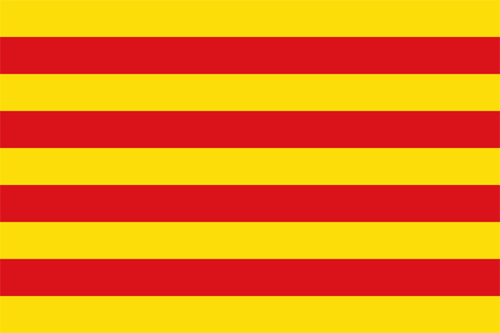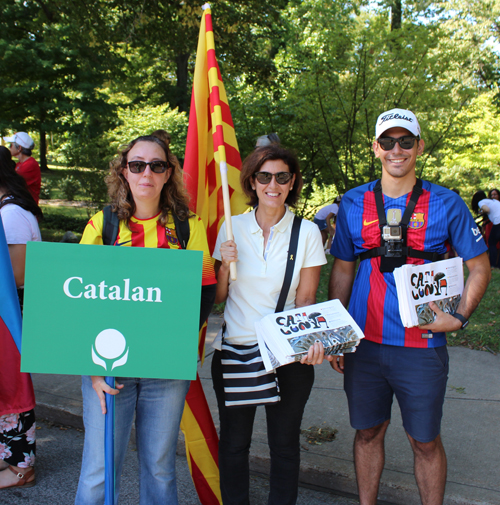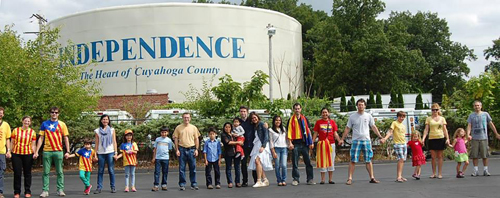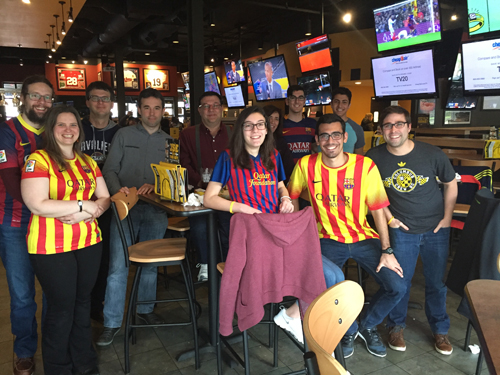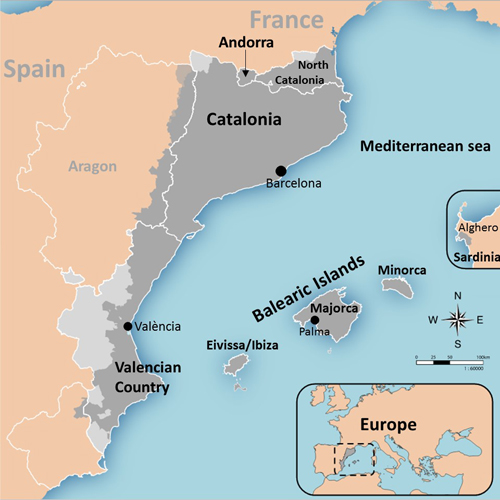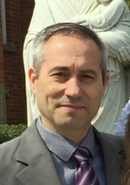Catalan History
The area now known as the Catalan Countries has been populated by (or under the influence of) Iberian tribes, Phoenicians, Greeks, Carthaginians, Romans, Visigoths and Andalusians. The modern origin of Catalonia dates to the second half of the 9th century, when the Frankish king Charlemagne conquered Roussillon, Andorra and several cities on the eastern Pyrenees mountains. Barcelona was captured by the Franks in 801, and the new conquered land was organized in several Catalan Counties.
During the High and Late Middle Ages the Catalan domains expanded in multiple directions to form a maritime empire that included (at some point) the principalities of Catalonia and Andorra, the kingdoms of Majorca, València, Múrcia, Navarre, Naples, Sicily and Sardinia, the islands of Corsica and Malta, the Greek dukedoms of Athens and Neopatras and numerous counties in Occitania and around the Mediterranean. Multiple "Consulates of the Seas" were established all over the Mediterranean, some as far away as the Holly Land and Egypt, to administer maritime and commercial law. The Kingdoms of València and Majorca were repopulated mainly by Catalan-speaking people, hence their current Catalan character.
The Catalan Crown has been given different names over the centuries, such as "the Royal Crown", "Kingdom, Domains and Crown of Aragon and of Catalonia", "Crown of Aragon and the County of Barcelona", etc., although in modern times it has been known as "Crown of Aragon". The marriage of King Ferdinand II of Aragon and the Queen Isabella I of Castile in 1469, did not mean the unification of their domains into one kingdom or crown.
Early in the 18th century, the Crown of Aragon was invaded by Bourbon troops. València fell in 1707, Barcelona in 1714 and Majorca in 1715. These lands were incorporated into Spain, their government institutions and laws were abolished, and public use of Catalan language was prohibited with the New Regime Decrees.
Soon after the death of the Spanish dictator Francisco Franco, in 1975, Catalonia, Valencian Country and the Balearic Islands recovered their medieval government institutions, although with limited power, inside a quasi-federal Spain. Barcelona modernized and came to world-wide prominence during the Olympic games of 1992.
 Barcelona
Barcelona
During 2009 and 2010, "popular referendums" (organized by ordinary citizens) on the independence of the Catalan nation were held in 170 Catalan cities and many Catalan communities abroad. The popular referendum of the Catalan community in the USA was held on October 9, 2010, co-organized by Catalans in San Diego, San Francisco, Cleveland and New York, with a result of 95.2% in favor of independence. The combined result of all these "popular referendums" was an overwhelming 94.9% vote for independence. In 2014, the Catalan government sponsored a non-binding referendum on the independence of Catalonia. The result was an 81% votes for independence, 10% in favor of a federal solution, 4.5% rejected any change in the current status, whereas the remaining 4.5% were blank and null votes. Catalan Language and Culture:
Catalan is a romance language currently spoken by 8 to 10 million people. By the 9th century, Catalan had evolved from Vulgar Latin on both sides of the eastern end of the Pyrenees, as well as some of the territories to the south. By the end of the 10th century, Catalan was already a fully-formed language, clearly distinguishable from its Latin origins. The Homilies of Organyà, written in the late 12th or early 13th centuries, is the first extant text written originally in Catalan. The earlier Cançó de Santa Fe, from 1054-76, may be Catalan or Occitan. 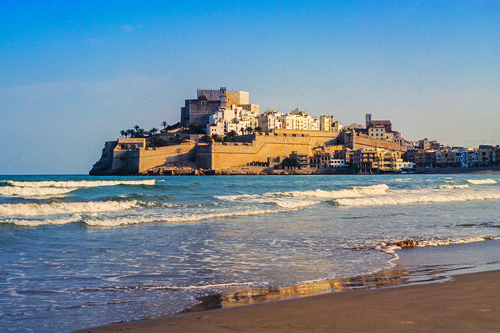 Penyiscola Penyiscola
Catalan poetry flourished from the 13th century, before which Catalan poets wrote in Provençal. The first true Catalan poet was the Majorcan Ramon Llull (1232-1316), and the greatest Catalan poet was Ausiàs March (1397-1459), a Valencian. The Four Great Chronicles are major literary works in Catalan written between the 13th and 14th centuries narrating the deeds of the monarchs and leading figures of the Catalan Crown.The 15th century witnessed the peak of Catalan influence on the Western world, illustrated by the presence of two Valencian Popes in the Vatican in 50 years, against a long-held tradition of Italian Popes. During the Late Middle Ages, Catalan was the lingua franca (bridge language between speakers whose native languages are different) in the Mediterranean basin. By the 15th century, the city of Valencia had become the sociocultural center of the Crown of Aragon. Catalan was the official language in the dukedom of Athens during most of the 14th century, in Sicily until the 15th century, and in Sardinia until the 17th century. The golden century of Catalan literature is represented by the novel Tirant lo Blanch by Joanot Martorell (published in 1490), an epic romance that was later hailed as the best book in the world by Cervantes. This book was translated to numerous languages and is considered by some as the first modern novel of the western literature. Suddenly, at the peak of this period of splendor, Catalan-speaking people apparently fell into a period of a total unproductivity. No significant cultural developments seem to have occurred in the Catalan Countries from the 16th to the 19th century. This historical "black box" coincides with a strict policy of censorship (and translation to Spanish) of most publications, imposed by an increasingly Castile-centric monarchy. Catalan scholars are now trying to recover, from direct or indirect sources, the information from this period that has been erased or hidden from history. 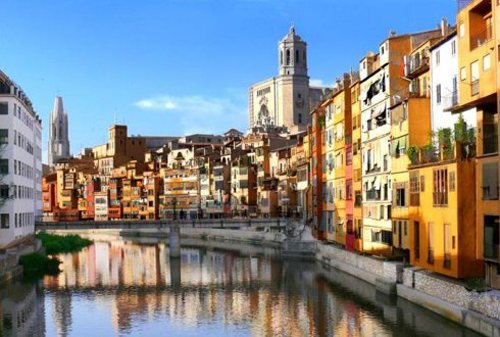 Girona
Girona
The Catalan renaissance (Renaixença) began in the late 19th century with the economic progress of Catalonia, but it suffered another setback during the dictatorship of Francisco Franco (1939-1975). Today Catalan is a completely normalized language with a healthy literature, and it is taught in the schools of Catalonia and Andorra as a first language. Unfortunately, in the rest of the Catalan Countries many children are not able yet to be educated in Catalan. The Institute of Catalan Studies is responsible for establishing and updating the standard language, which is based on the Barcelona dialect with some admixtures from Valencian. Valencia
Valencia
Personalities of the Catalan Countries:
Ramon Llull (1232-1316) was a Majorcan philosopher, novelist, poet, theologian, mystic, mathematician, logician, visionary and missionary. He is credited with writing the first major work of Catalan literature. He was one of the first Europeans to use a vernacular to write works on theology, philosophy, and logic. Recently surfaced manuscripts show his work to have predated by several centuries prominent concepts on elections theory. He is also considered a pioneer of computation theory, especially given his influence on Gottfried Leibniz. Thanks to his long life, he has able to create a monumental work with at least 265 books in Catalan, Latin, Arab, Occitan, French, Italian and Castilian. Llull also wrote an Arabic-Catalan dictionary, the first Arabic dictionary of a western language. His Book of the Order of Chivalry (1276) was translated to different languages and was very influential during the Late Middle Ages.
James I "The Conqueror" (1213-1276) was King of Aragon, València and Majorca, Count of Barcelona and Lord of Montpellier. His long reign saw the expansion of the Catalan domains in three directions: Languedoc to the north, the Balearic Islands to the south, and València to the southwest. James compiled the Llibre del Consolat de Mar (Book of the Consulate of the Seas) which governed maritime trade and helped establish Catalan supremacy in the western Mediterranean. He was an important figure in the development of the Catalan language, sponsoring Catalan literature and writing an autobiographical chronicle of his reign in the Libre dels feyts (Book of Deeds). This book gave unprecedented insights into the life and conquests of a medieval king, and it was imitated by three other Catalan kings (or their chroniclers).
Ausiàs March (1400-1459): Valencian poet and knight from Gandia. He is considered one of the most important poets of the "Golden Century" (Segle d'or) of Catalan literature.
Joanot Martorell (14131468): Valencian knight and writer born in Gandia. He is the author of the epic romance Tirant lo Blanch written in Catalan. It deals with the adventures of a crusader knight in the Byzantine Empire. The novel is partly autobiographical, but at times it parallels the life of Roger de Flor, leader of the Company of Almog vers. Miguel de Cervantes considered it the best book in the world, therefore saving it from the fire in Don Quixote. It is one of the best known medieval works of literature and played an important role in the evolution of the Western novel, being also a precursor of the present-day genre of alternate history. During more than two centuries Tirante el blanco was thought to be an anonymous classic of Spanish literature because the oldest known copy was from the 1511 Valladolid edition, in Spanish. Fortunately, four older copies in Catalan with the author's name and edition dates (1490 and 1497), were found in Rome in the 18th century. All the other copies from these first two editions of the book have 'disappeared'. Tirant lo Blanch is not the only case of 'linguistic substitution' of Catalan culture during the 16th century.
Pope Alexander VI [Roderic Borja] (1431-1503), born in Xàtiva, was the second Borgia Pope. Alexander VI became a byword for libertinism and nepotism; however, two of Alexander's successors, Sixtus V and Urban VIII, described him as one of the most outstanding popes since St. Peter. The dark legend of the Borgia family was probably contributed to by the Italian Catholic hierarchy, because he (and his uncle) broke a long-held tradition of Italian papacies, and he modernized the Vatican often opposing the opinions of the Curia. One of Alexander's children, Cesare Borgia, was used as an example of a successful ruler in The Prince by Niccolò Machiavelli.
Antoni Gaudí (1852-1926) was a Catalan architect from Reus and the best known practitioner of Catalan Modernism. Gaudí's works reflect an individualized and distinctive organic style. Most are located in Barcelona, including his magnum opus, La Sagrada Família. Between 1984 and 2005, seven of his works were declared World Heritage Sites by UNESCO.
Salvador Dalí (1904-1989) was a prominent surrealist painter born in Figueres. Dalí was a skilled draftsman, best known for the striking and bizarre images in his surrealist work. His best-known work, The Persistence of Memory, was completed in August 1931. Salvador Dalí's manic expression and famous moustache have made him something of a cultural icon for the bizarre and surreal. He has been portrayed on several films. The Dali crater on the planet Mercury is named after him. One of Dalí's museums is in St Petersburg, FL.
Pau Casals (1876-1973) was a world-class cello player and composer. He is remembered also by his speech at the United Nations in 1971 praising Catalonia
Cuisine from the Catalan Countries:
The food of the Catalan Countries is very diverse and regional. The most popular dishes are the Valencian paella, seafood paella, fideuà, all i pebre (from Valencia Country), escalivada, escudella, calçots (from Catalonia), sobrassada and ensaimada (from Majorca). Coca, a dish similar to pizza, is common to the Catalan Countries but it also shows profound regional variations.
 Paella Paella
Tell us about the music, food, holidays, traditions, costumes, language and other qualities that makes Catalans so special.
Submit your Cleveland Catalan cultural items.
|

